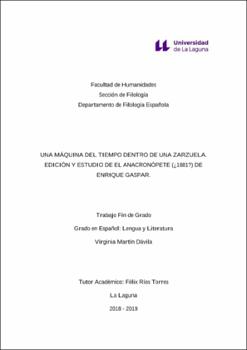Una máquina del tiempo dentro de una zarzuela. Edición y estudio de El Anacronópete (¿1881?) de Enrique Gaspar
Author
Martín Dávila, VirginiaDate
2019Abstract
La novela de Enrique Gaspar El anacronópete (1887) ha sido reeditada en diversas
ocasiones en las últimas tres décadas. Los motivos que han llevado a esta sucesión de
ediciones es que en ella se encuentra la primera aparición de una máquina del tiempo en
la literatura occidental. Sin embargo, y pese a que algunos críticos lo han señalado, no
se ha producido ninguna edición de la zarzuela que lleva el mismo nombre y que sería
anterior a la novela. El «olvido» por parte de la crítica de estas obras se debe a que
ambas no se encuentran enmarcadas dentro de las piezas de tesis del autor ni del teatro
realista por el que es conocido.
Este hecho nos ha movido a realizar una transcripción y edición de El
anacronópete (¿1881?), así como un comentario crítico de la misma y un breve estudio
comparativo entre las dos obras, pues consideramos que no se trata de una creación
marginal y, por tanto, desvinculada del resto de sus obras, sino que es un eslabón más
dentro de su producción, que nos muestra el interés del autor por el cientificismo que
tan de moda estaba en su época y al que dedicó al menos seis obras. The work of Enrique Gaspar El anacronópete (1887) has been reissued several
times in the last three decades. The reasons that lead to this succession of editions is
that it is the first appearance of a time machine in Western literature. However, and
although some critics have pointed out, there has been no edition of the zarzuela that
bears the same name and that predates the novel that we have just mentioned. This
"forgetfulness" on the part of the critic of these two works is due to the fact that these
are not framed within the works of the author's thesis, nor of the realist theater, for
which he is known.
This fact has moved us to make a transcription and edition of El anacronópete
(1881?), As well as a critical commentary on it and a brief comparative study between
the homonymous works. Well, we consider that it is not a marginal creation, and
therefore, disconnected from the rest of his works, but it is one more link in his production, which shows the author's interest in the scientistic subject that was so
fashionable epoch and to which he dedicated at least six works.





